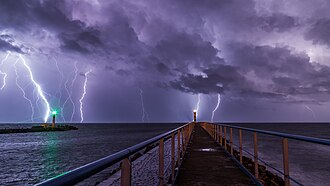
Back Weerlig Afrikaans መብረቅ Amharic चीरिंग ANP برق Arabic ܒܪܩܐ ARC Rayu AST Illapa Aymara Şimşək Azerbaijani Йәшен һәм ялағай Bashkir Tatit BAN

| Part of a series on |
| Weather |
|---|
|
|
Lightning is a natural phenomenon formed by electrostatic discharges through the atmosphere between two electrically charged regions, either both in the atmosphere or one in the atmosphere and one on the ground, temporarily neutralizing these in a near-instantaneous release of an average of between 200 megajoules and 7 gigajoules of energy, depending on the type.[1][2][3] This discharge may produce a wide range of electromagnetic radiation, from heat created by the rapid movement of electrons, to brilliant flashes of visible light in the form of black-body radiation. Lightning causes thunder, a sound from the shock wave which develops as gases in the vicinity of the discharge experience a sudden increase in pressure. Lightning occurs commonly during thunderstorms as well as other types of energetic weather systems, but volcanic lightning can also occur during volcanic eruptions. Lightning is an atmospheric electrical phenomenon and contributes to the global atmospheric electrical circuit.
The three main kinds of lightning are distinguished by where they occur: either inside a single thundercloud (intra-cloud), between two clouds (cloud-to-cloud), or between a cloud and the ground (cloud-to-ground), in which case it is referred to as a lightning strike.[4][5] Many other observational variants are recognized, including "heat lightning", which can be seen from a great distance but not heard; dry lightning, which can cause forest fires; and ball lightning, which is rarely observed scientifically.
Humans have deified lightning for millennia. Idiomatic expressions derived from lightning, such as the English expression "bolt from the blue", are common across languages. At all times people have been fascinated by the sight and difference of lightning. The fear of lightning is called astraphobia.
The first known photograph of lightning is from 1847, by Thomas Martin Easterly.[6] The first surviving photograph is from 1882, by William Nicholson Jennings,[7] a photographer who spent half his life capturing pictures of lightning and proving its diversity.
There is growing evidence that lightning activity is increased by particulate emissions (a form of air pollution).[8][9][10] However, lightning may also improve air quality and clean greenhouse gases such as methane from the atmosphere, while creating nitrogen oxide and ozone at the same time.[11] Lightning is also the major cause of wildfire,[12] and wildfire can contribute to climate change as well.[13] More studies are warranted to clarify their relationship.
- ^ Maggio, Christopher R.; Marshall, Thomas C.; Stolzenburg, Maribeth (2009). "Estimations of charge transferred and energy released by lightning flashes in short bursts". Journal of Geophysical Research: Atmospheres. 114 (D14): D14203. Bibcode:2009JGRD..11414203M. doi:10.1029/2008JD011506. ISSN 0148-0227.
- ^ "SEVERE WEATHER 101 - Lightning Basics". nssl.noaa.gov. Retrieved October 23, 2019.
- ^ "Lightning Facts". factsjustforkids.com. Retrieved October 23, 2019.
- ^ "Severe Weather Safety Guide" (PDF). National Weather Service. 2022.
- ^ "Lightning Facts". Fast Facts for Kids. 2022. Archived from the original on September 28, 2022. Retrieved July 27, 2022.
- ^ "The First Photographs of Lightning Crackle with Electric Chaos". Hyperallergic. May 25, 2016. Retrieved May 12, 2019.
- ^ "These are the World's First Photos of Lightning". PetaPixel. August 5, 2020.
- ^ "Air pollution helps wildfires create their own lightning".
- ^ "Pollution boosts risk of lightning". February 13, 2018.
- ^ "A Bolt from the Brown: Why Pollution May Increase Lightning Strikes". Scientific American.
- ^ "Lightning Produces Molecules that Clean Greenhouse Gases from the Atmosphere".
- ^ "What causes wildfire".
- ^ "Climate Change Indicators: Wildfires, US EPA". July 2016. Retrieved July 6, 2023.